I have made a TForm derivative that acts like the drop down part of a combo, or a hint window, or a popup menu - a temporary thing. It has no caption - its BorderStyle is set to bsNone. The form is displayed non-modally using Show, having set its position.
To make it stand out, it needs a drop shadow around its border. However, a consequence of setting its border to bsNone is that the drop shadow disappears.
Various Google sources suggest variations of this:
procedure TdlgEditServiceTask.CreateParams(var Params: TCreateParams);
const
CS_DROPSHADOW = $00020000;
begin
inherited;
{ Enable drop shadow effect on Windows XP and later }
if (Win32Platform = VER_PLATFORM_WIN32_NT) and
((Win32MajorVersion > 5) or
((Win32MajorVersion = 5) and (Win32MinorVersion >= 1))) then
Params.WindowClass.Style := Params.WindowClass.Style or
CS_DROPSHADOW;
end;
but it doesn't work - the shadow is not displayed (unless I also set a resizable border with WS_THICKFRAME set, which looks terrible). This is a popup window, not a child window, so I don't see why it should fail.
Suggestions please?
NB: this is a similar question to this question, which remains unanswered.
NB2: There is an obscure VCL component called TShadowWindow that looks like it will do the right thing, but turns out to be too crudely written to be practical.
Update: Following Andreas' comments below, I have investigated this further, and found some niceties.
Under Windows 7, I discovered that the shadow does not appear when the popup window if it is over another window from the same application.
Here is a simple Delphi app, which uses CreateParams on a popup window to request a shadow as described above.

See how the drop shadow appears where it extends beyond the main window?
But I want to use the borderless window as a popup over the main window. The drop shadow distinguishes the popup from the window underneath. All my description up above refers to this circumstance. Obviously some Windows mechanism is interfering here.
I have also tried the same application under Windows XP. Here is how it looks.

This works correctly with shadow everywhere*. Gah!
So it would seem to be a Vista/W7 thing, as Andreas suggests.
(*An earlier version of this text and screendump suggested that no shadow appeared. However, this turned out to be because I had the Windows XP display option 'Shadows under menus' turned off. Duh.)

